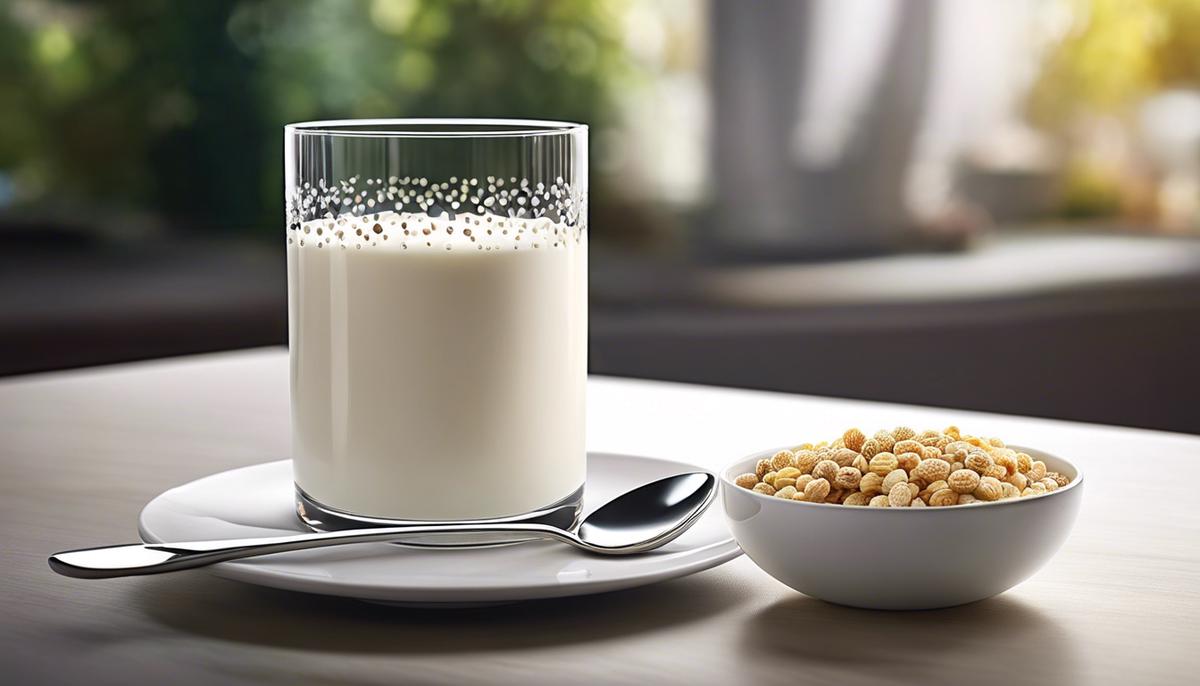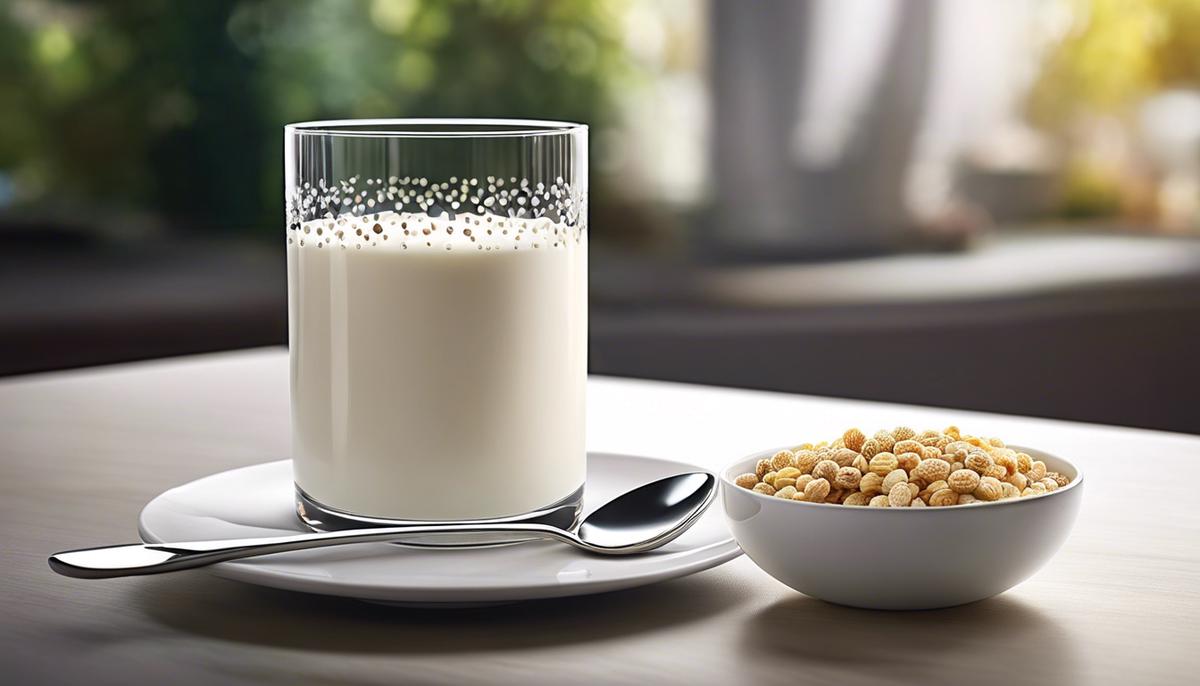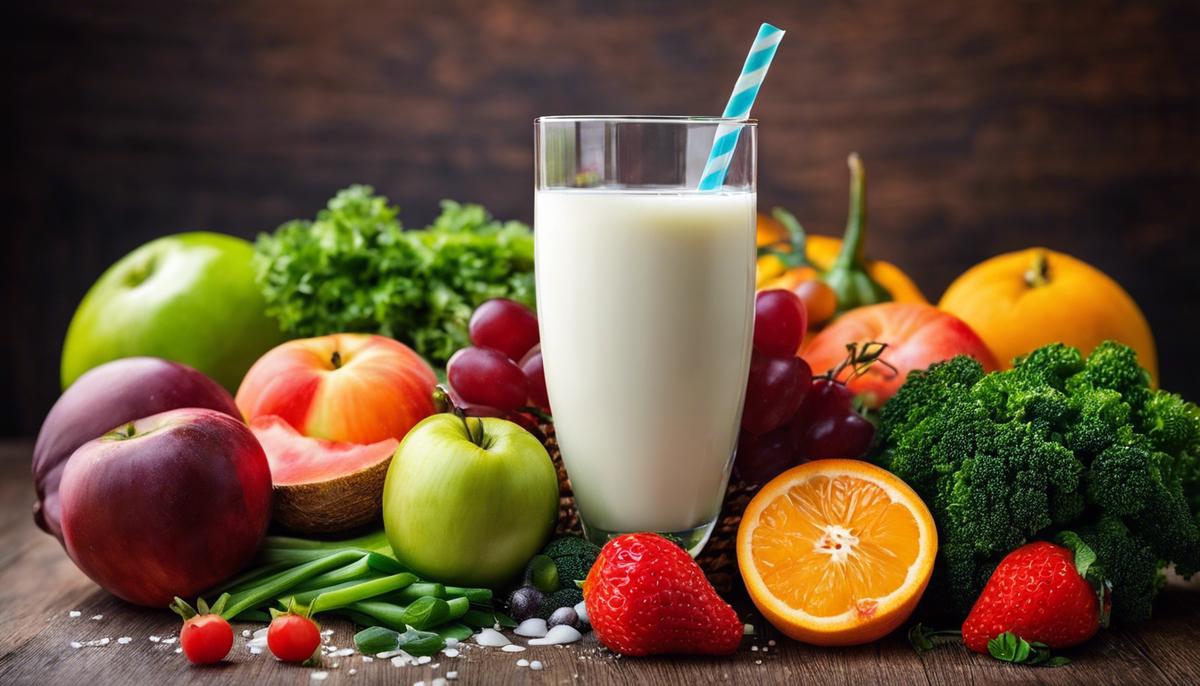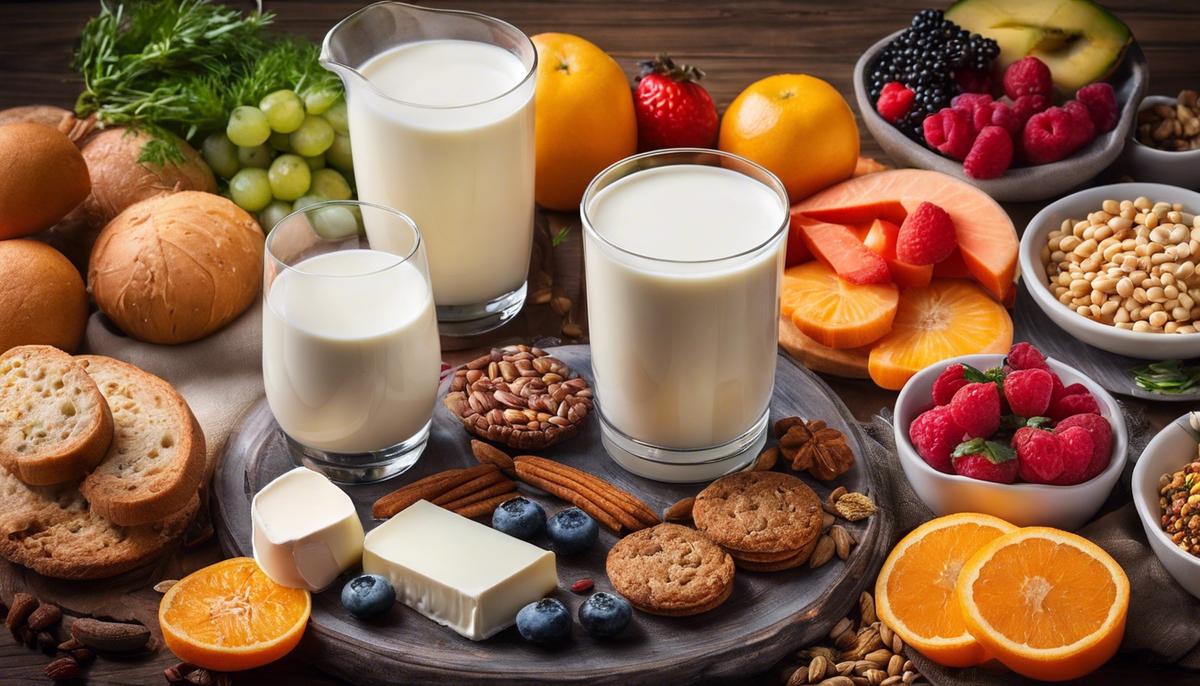

Agridisk
Egypt - Alexandria

All about whole milk nutrition & skim milk nutrition
Description: Imagine an easily accessible food source that offers an array of vital nutrients in one go. A food that not only provides essential macronutrients like proteins, carbohydrates, and fats, but also brims with critical micronutrients including a variety of vitamins and minerals. This power-packed food is none other than whole milk. Adorned with a rich nutritional profile, whole milk forms an integral part of numerous diets worldwide. But, there seems to be a veil of myths and misconceptions around its consumption. This detailed examination of whole milk sheds light onto its chemical composition, health benefits, counter-arguments to the prevalent myths, and comparison with its other dairy counterparts — opening a new perspective on how whole milk can contribute to all-round health and wellness. Decidedly enthralling and undoubtedly intricate, the study of the chemical components of whole milk furnishes not only crucial insights into nutrition and food science, but also presents an excellent example of the complex chemical makeup of commonplace substances. This discourse intends to elucidate upon the seminal constituents of whole milk's chemical arrangement. Launching our analysis into the heart of the subject, whole milk is popularly recognized for its rich concentration of nutrients which, when accurately perceived, are essentially an array of chemical elements interacting in a particular order. At its core, whole milk is approximately 87.7% water (H2O). Deceptively simplistic, this water component is a fundamental solvent, rendering it an essential facilitator for the vital, life-sustaining chemical reactions necessary for all organisms, including humans. The residual 12.3% of whole milk is a multifaceted combination of fats, proteins, minerals, and carbohydrates. Let's dissect these components further. Firstly, approximately 3.4% of whole milk is composed of proteins, the most vital of which are casein and whey. These chemicals are polymers of amino acids - the building blocks of life - and play a critical role in the growth and maintenance of the human body. Further analysing, about 4.8% of whole milk's composition is attributed to carbohydrates, with the primary contributor being lactose ( Subsequently, circling towards fats, they constitute about 3.3% of whole milk's composition. Primarily triglycerides, these fats supply an unparalleled energy source, assist in the absorption of fat-soluble vitamins, and endow milk with its characteristic creamy texture. And not to be sidelined, the mineral constituency of whole milk (around 0.7%) carries essential elements like calcium, potassium, and phosphorous, making whole milk a vital resource for bone health and other bodily functions. To be sure, this discourse doesn't aim to cast each and every one of whole milk's components under the microscope; the biochemical mosaic of milk encompasses a myriad of other trace elements, vitamins, and enzymes that synergistically contribute to its nutritional profile. However, by outlining the primary chemical constituents, this endeavour aims to stimulate a deeper appreciation for the complex, life-sustaining chemical ballet that dances on in a seemingly mundane glass of whole milk, creating avenues for further queries and investigations in our ceaseless quest for knowledge and understanding. Crucial to an in-depth comprehension of how consuming whole milk influences health are the physiological processes affected by its consumption. Our bodies utilize the substances present in milk in an impressive variety of ways, shaping not only our physical health but also our metabolic, immune, and even cognitive functions. Considering whole milk's protein content, an integral aspect that stands out is its essential amino acids availability. These building blocks of human proteins are termed 'essential' because our bodies can't synthesize them. Consequently, we need to incorporate them into our diet. The proteins in whole milk, including casein and whey, are complete proteins; they provide all the essential amino acids needed for muscle growth, tissue repair, and production of antibodies that are pivotal to a stalwart immune response. Delving deeper into the fantastic realm of metabolism, lactose, a carbohydrate found in milk, plays an integral role in energy production. Digestion of lactose yields glucose and galactose, which provide energy to our cells. Furthermore, studies propose a potential indirect benefit on gut health owing to lactose. Certain intestinal bacteria ferment lactose, leading to the production of lactic acid - a substance correlated with a balanced gut microbiome. The fat component of whole milk, besides impregnating it with a delightful creaminess, serves as a rich energy source and facilitates the absorption of fat-soluble vitamins, such as vitamins A, D, E, and K. Furthermore, the unique structure of milk fat globules enhances their digestibility, while specific fatty acids present, like Omega-3 fatty acids, contribute to heart health and cognitive function. Continuing the journey beyond, a wealth of minerals in whole milk awaits to be tapped into by our bodies. Prominently, calcium plays an undisputed role in bone and dental health, while also assisting in blood clotting and muscle contractions. Potassium regulates blood pressure and heart function, and phosphorous partners with calcium to bolster bones and teeth while aiding energy release from food. In addition to the primary constituents, whole milk teems with more subtle contributors to health - trace elements, vitamins, and enzymes. For instance, riboflavin (Vitamin B2) is involved in energy production and cell function, while Vitamin B12 keeps the body's nerve and blood cells healthy. Examining whole milk in the light of biochemistry and nutrition paints a vivid image of a naturally synthesised, nutrient-dense liquid that nourishes us bit by bit, helping shape our physiological trajectory. Whole milk is indeed a testament to the complexity and wonder of the biological world and its study offers us a remarkable pathway to comprehend the intricacies of our own bodies. Perhaps, then, a glass of whole milk is not just a drink, but rather a life-sustaining potion served in a humble guise. Misconceptions about Whole Milk Not to shy away from demystifying popular, though often erroneous, beliefs, let's delve into some of the prevailing misconceptions surrounding whole milk. It is of utmost importance that these myths are dispelled to grant individuals the knowledge required to make informed dietary decisions. Myth: Whole Milk is High in "Bad" Fat Undoubtedly, whole milk does contain fat; but it would be hasty to label these fats as categorically 'bad'. In truth, whole milk is a source of both saturated and unsaturated fats. Research reveals that a moderate intake of saturated fats, contrary to traditional belief, does not necessarily increase the risk of heart disease. Furthermore, the unsaturated fats present are heart-healthy and include Omega-3 fatty acids, which are associated with an array of health benefits, such as boosting brain and eye health. Myth: Whole Milk Leads to Obesity Whole milk, an often-avoided dietary element in society's battle against obesity, is not the enemy it’s often construed to be. Several studies have, in fact, linked whole milk consumption with lower body weight and reduced risk of metabolic diseases. Individuals who include whole milk in their diet may actually benefit from its satiating effects, which in turn can help manage food intake and potentially assist in weight regulation. Myth: Milk Causes Lactose Intolerance Lactose, the natural sugar found in milk, is attributed a villainous role too frequently in narratives of lactose intolerance. Nonetheless, it is a misunderstanding to believe that consuming milk invariably causes lactose intolerance. This gut dysfunction primarily strikes those who lack sufficient lactase- the enzyme necessary to digest lactose. While it is true that a segment of the global population is lactase deficient, many others can consume milk and other dairy products comfortably, without the feared gastrointestinal symptoms. Myth: Milk Is Not Essential in an Adult Diet The calcifying power of milk and dairy products has been inextricably linked to the bone health of growing children. The misleading misconception is that adults, once past the growth stage, no longer require milk in their diet. However, the rich array of essential nutrients present in whole milk, beyond being merely 'beneficial,' is vital for adults, supporting bone health, muscle maintenance, cellular function, and overall body resilience. Taking a scientific lens to whole milk consumption dispels prejudiced, unfounded fears. Backed by solid research and the process of scientific interrogation, we can reaffirm that whole milk, in moderation, forms part of a balanced diet, supporting an array of essential physiological functions across all age colonies. As such, it continues to form a vital part of human nutrition and health. Exploring the Comparative Nutrition of Milk Varieties After a deep dive into the multifaceted nature of whole milk’s nutritional profile, it's time to extrapolate and compare these findings with its counterparts: skimmed and semi-skimmed milk. Intriguingly, but not surprisingly, the primary differences lie in their caloric value and fat content. Skimmed milk, by design, is devoid of fat. The process of skimming removes almost all the fat content, resulting in a significantly lower-calorie serving. This naturally impacts the dietary energy and concentration of fat-soluble vitamins like A, D, E, and K. While these vitamins are often added back artificially, the absence of fats means the body’s absorption may be limited. This is because these crucial vitamins naturally require fats for optimal bioavailability. Semi-skimmed milk straddles the divide between whole and skimmed milk, maintaining roughly half of whole milk’s fat content. In terms of calories, it occupies the middle ground, making it a popular choice for those seeking balance in nutrient intake without a significant dip in creamy taste and texture. In addition to maintaining a more balanced nutrient profile, it still possesses substantial quantities of bone-friendly calcium and phosphorus. However, calculating the value of milk variety based solely on calorie and fat content may overlook the role of dietary fats in overall health. The fats in whole milk are not inherently "bad". In fact, they comprise saturated, monounsaturated, and polyunsaturated fats, alongside cholesterol. Each plays a significant role in cellular function, hormone production, and brain health. While whole milk bears the brunt of blame for weight gain, research increasingly suggests the link between whole milk and obesity is not as clear-cut. Moderation and balance in consumption, in line with an individual's energy requirements, are key. Lactose intolerance, on the other hand, is an inherent bodily inability to digest lactose and isn’t caused by the consumption of milk. Persons with this condition can explore lactose-free milk options which deliver similar nutrient benefits without the discomfort. Milk, though not quintessential in an adult diet, certainly enhances it. As an exceptional source of essential nutrients like protein, B vitamins, and minerals, it's an easy route to nutritional content many adults may miss out on, especially in diets lacking in variety. A broader perspective thus illuminates that while skimmed and semi-skimmed milk have their virtues, particularly for those needing specific dietary adjustments, they are not categorically healthier than whole milk. Each shows its strength in a well-balanced diet, adjusted for the diverse metabolic and physical needs of the individual. Recognising the intrinsic value of these variants and tailoring consumption to personal nutritional goals, may be a more constructive and enlightened approach towards dairy consumption for health and wellbeing. Irrespective of the variety, milk in its fundamental form is rightly considered a wholesome food given its impressive nutritional profile. However, when it comes to whole milk, its utility extends beyond mere numbers on the nutrition facts label. It emerges as an excellent source of macronutrients and micronutrients that play a critical role in ensuring optimal health. From its essential contribution to bone health, cell maintenance, growth and development in kids, to its potential role in weight management, whole milk indeed carries a plethora of benefits. However, as with any food item, the key lies in understanding our individual health needs and maintaining a balanced diet. So, whether you prefer whole milk, skimmed or semi-skimmed, remember that moderation coupled with balance is the recipe for a healthy life! The role of skim milk in diet and human health is an intriguing discourse, attracting substantial debates both in academic and public spheres. This diverse discussion entails evaluating the nutritional content of skim milk - from its abundant protein concentration and mineral composition to a miscellany of essential vitamins. Besides, making comparisons with other dairy products offers a broader perspective, especially in light of caloric and fat contents, to underscore its potential suitability for individuals with dietary restrictions. This balanced evaluation further considers the impact of skim milk consumption on human health, elucidating the potential benefits and risks based on genuine scientific research, and potential allergenic reactions. Finally, practical schemes to incorporate skim milk into various dietary plans - be it vegetarian, low-fat, or high-protein diets, are revealed for a flexible application based on individual preferences and nutrition goals. The Remarkable Nutrient Profile of Skim Milk and its Impact on Human Health Skim milk, an everyday dietary staple for many people worldwide, is far from mundane when it comes to its nutrient profile. Despite the absence of fat, skim milk remains a potent source of several essential nutrients scientifically proven to be quintessential to human health. Firstly, it is of note that skim milk is an exceptional provider of high-quality protein. Proteins are the main building blocks of the human body, playing a crucial role in cellular repair, enzyme production, and maintaining muscle mass, among other functions. Per every 8-ounce glass of skim milk, you imbibe 8 grams of proteins, equal to the amount in an egg, reinforcing the structural and functional abilities of the body. Calcium, a well-renowned mineral abundantly found in skim milk, is indispensable for the health and vitality of bone structures. Roughly 99% of the body's calcium resides within our bones and teeth, bolstering their density and strength. Moreover, calcium also participates in nerve conduction, blood clotting, and muscle contraction. A single serving of skim milk provides about 30% of the daily recommended intake of this critical nutrient. Nestling within skim milk is also a considerable quantity of vitamin D. Contrary to popular understanding, vitamin D is not just a single entity but an assembly of fat-soluble seco-steroids. Vitamin D and calcium operate in tandem; the vitamin improves the absorption of calcium and phosphorus from the digestive tract, thereby augmenting bone health. Furthermore, vitamin D also modulates the immune system and aids in cellular growth. Meanwhile, the vitamin B12 in skim milk renders vital assistance in the wellbeing of the nervous system whilst also aiding the production of DNA, the genetic material in all cells. B12 deficiency, while rare, can lead to severe neurologic problems and blood diseases. Every cup of skim milk also delivers a significant amount of riboflavin (Vitamin B2), which aids in the conversion of ingested food into usable energy. Simultaneously, it also plays a role in cellular function, growth, and development, enhancing overall health. Plus, skim milk provides iodine, an important mineral vital for healthy thyroid function, which regulates the body's metabolism. It also plays a role in proper bone and brain development during pregnancy and infancy. While the term "skim" might suggest a less beneficial profile, it is apparent that skim milk is a powerhouse of crucial macro and micronutrients, sustaining and enriching human health in indispensable ways. Embracing this everyday dietary component could thus serve as a compelling approach toward nurturing overall health and vitality. An Exploration of Skim Milk's Nutritional Profile in Relation to Other Dairy Products Admittedly, the dialogue surrounding skim milk's nutritional profile is filled with extensive comparisons with other dairy products. This takes into consideration not only the relative amounts of nutrients, but also factors such as fat content and caloric value, each playing a significant role in influencing health outcomes. An eminent nutrient in this discourse is potassium. Skim milk is enriched with potassium which alongside sodium maintains fluid balance, regulates blood pressure, and facilitates nerve signals and muscle contractions. Notably, one cup of skim milk provides about 12% of the recommended daily intake of potassium, surpassing the concentration in most cheeses. Moreover, as a pivotal source of phosphorus, skim milk stands rival to other dairy products. This mineral is essential for energy production, bone health, and cellular repair. Classified as the second most abundant mineral in the body, the phosphorus in a cup of skim milk constitutes approximately 20% of an adult's daily needs. Not to forget, skim milk judiciously contributes to the daily protein intake - underpinned by the presence of both casein and whey protein. Although comparable to other dairy products in this aspect, arguably, this protein slant of skim milk accommodates those striving for lower caloric and fat intake. Interestingly, skim milk is a reservoir of vitamins A and E, unlike some other dairy products. Vitamin A is a fat-soluble vitamin that bolsters vision, immune function, and reproductive health. Vitamin E, another fat-soluble antioxidant, is crucial for shielding body cells against the damage triggered by free radicals. Still, it is crucial to understand that not all people respond equivalently to skim milk. This challenges the one-size-fits-all notion, emphasizing tailored dietary advice based on individual health status, lifestyle, and preferences. In parallel, it cannot be denied that the ongoing evolution in the dairy industry, like the course of fortification and functional foods, play a determinative role in shaping the nutritional profile of skim milk, as well as other dairy products. Hence, it is also a welcoming prospect to have future research thrust on these dimensions. Given the variances in the nutritional compositions across dairy products, it becomes imperative to make informed choices that effectively cater to individual dietary needs. In this journey of nutrition optimization, understanding the pivotal role of each nutrient and the indispensable offerings of dairy products like skim milk can be an enlightening start. In light of the previously discussed nutritional components of skim milk, it is also worth noting other significant nutrients such as potassium and phosphorus that play key roles in overall health. Amongst these is potassium, an essential mineral notable for its role in maintaining proper heart, muscle and nerve functioning. Regular consumption of skim milk can indeed be an excellent source of dietary potassium, which the body highly necessitates to offset the effects of sodium and help regulate blood pressure. Then there's phosphorus: a nutrient abundantly contained in skim milk. This mineral operates with a dual functionality, aiding both in energy production and fortifying skeletal structure. Indeed, it plays a part in nearly every chemical reaction in the body alongside its role in the molecular structure of DNA. Consuming phosphorus-rich foods, as skim milk is, can assist in maintaining a robust metabolism and enhancing bone health. While consuming protein is a human dietary requirement, individuals seeking a lower caloric intake would find skim milk applaudable. Apart from yielding fewer calories, the protein content in skim milk provides satiety, a feeling of fullness that can help manage weight control. In this context, the suitability of skim milk in an individual's diet plan, especially for those seeking weight loss, becomes more clear. Skim milk possesses a commendable presence of vitamins A and E, each conferring distinguished health benefits. Vitamin A generally supports vision, immune function, and cell growth whereas Vitamin E, a potent antioxidant, protects cells from the damage caused by free radicals. With the intriguing nutritional profile of skim milk, it's paramount to note that not all individuals respond to it in the same way. A multitude of factors such as genetics, lifestyle, medical history, and personal preference shapes each person's unique dietary needs. Therefore, tailored dietary advice for each individual becomes crucial, shining light on the importance of guidance from medical or dietary professionals. In the evolving landscape of modern dietary science, the fortification of skim milk and other dairy products has emerged as a significant trend. Fortification offers a technique to improve the nutritional profile of these products, incorporating essential nutrients that are ordinarily lacking. In a similar vein, the advent of functional foods, which have health-promoting properties beyond basic nutrition, have further advanced our understanding of dietary science. In conclusion, being informed about the nutritional profile of food items like skim milk and how they translate into health outcomes enables better dietary choices. The importance of such knowledge echoes in the premise of preventive healthcare, by keeping chronic diseases at bay. And as the dairy industry continues to evolve with new research and insights, a more detailed understanding of the nutritional aspects of foods like skim milk awaits us, offering a deeper comprehension of the complex puzzle that is human nutrition. The said nutrients are a part of the complex biochemical puzzle that renders skim milk an effectual dietary element in the wider sphere of nutrition planning. It's critical to go beyond the individual benefit-focused perspective and consider the synergistic interplay of these nutrients. For instance, the interaction between calcium, phosphorus, and proteins is essential for optimal bone health, as it is their collective action that ensures a robust skeletal infrastructure. Similarly, the complexes formed by proteins with vitamins and minerals are vital for an array of biological processes, extending from muscle synthesis to enzymatic activations. It is also noteworthy that skim milk stands as a lower calorie and fat variant, rendering it appropriate for those individuals seeking to regulate their caloric or lipid intake. Its high-quality protein content not only provides essential amino acids but also promotes the feelings of satiety that routinely assist in weight management. Advancing the discussion to the content of vitamins A and E in skim milk, their respective roles cannot be overstated. Vitamin A, a potent antioxidant and integral for normal vision, has a deterministic role in immune function and cell growth. Concurrently, Vitamin E, another powerful antioxidant responsible for guarding against cell damage, contributes extensively to the maintenance of overall health. However, it is obligatory to realize that the response to skim milk may vary among individuals, attributing to genetic predispositions, existing health conditions, or personal choices. This reinforces the urgency for individually tailored dietary advice, mirroring the nuances of personalized nutrition. Focusing on dairy fortification and the growth of functional foods, it appears the dairy industry is heading towards an era of judicious nutrient inclusion. Fortification is increasingly being explored to improve the nutritional profile of dairy products and promote health benefits. This calls for heightened awareness and understanding by consumers to make nutritionally informed food choices. Finally, it's also essential to highlight that the rapid evolution of the dairy industry harbors immense potential for future research, especially concerned with the nutritional profiles of dairy products. Such relentless exploration and innovation may unveil new ways in which skim milk and other dairy products can contribute to human health and nutrition, consequently offering intriguing insights into the fascinating world of dairy science. Given its nutrient-packed profile, skim milk undeniably offers a valuable contribution to diverse diet plans and general human health. The rich protein content, essential minerals, and array of vitamins provide nutritional sustenance, while its low caloric and fat content position it as a potentially beneficial inclusion in various diets, especially for weight management. Nonetheless, individual health implications must be considered, warranting a personalized approach to incorporate skim milk into daily nutrition. In essence, understanding the versatility and the nutritional value of skim milk paves way for a balanced, diverse, and health-focused dietary approach that can positively influence your wellbeing.All about whole milk nutrition & skim milk nutrition
Whole milk nutrition
Chemical Composition of Whole Milk
C12H22O11). Lactose, a disaccharide compound, is an invaluable source of energy for the body. It subsequently prompts the synthesis of lactic acid bacteria, which aids in maintaining good gut health.Health Benefits of Whole Milk

Debunking Myths Surrounding Whole Milk
Whole Milk vs. Other Varieties

Skim milk nutrition
Nutritional Content of Skim Milk

Comparison with Other Dairy Products

Impact of Skim Milk Consumption on Human Health

Skim Milk in Diet and Nutrition Plans
